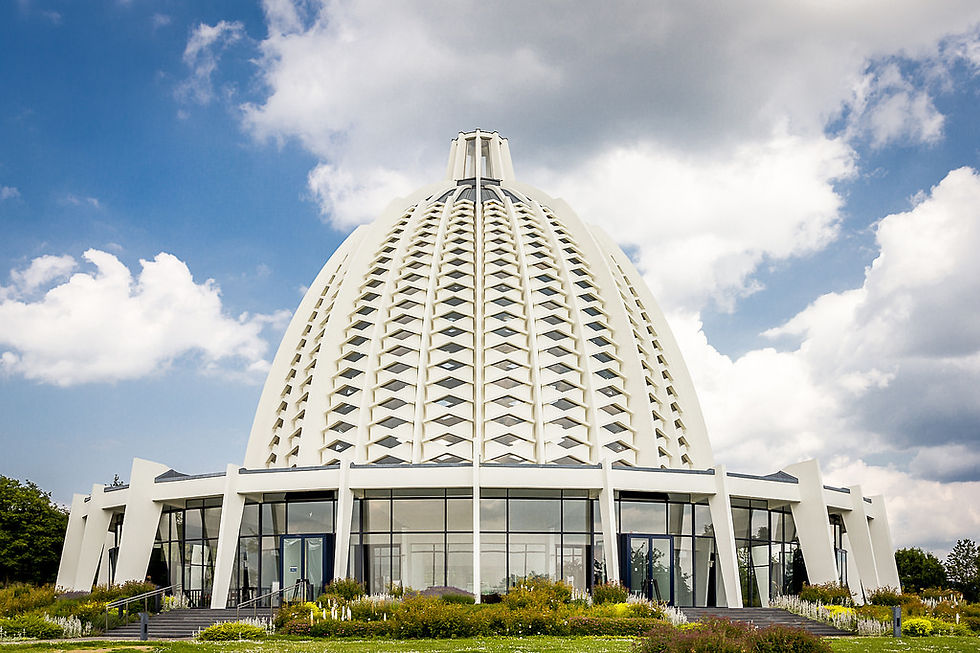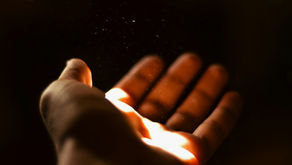What is a Mashriqu'l-Adhkár - Baha'i House of Worship
- Uplifting Words

- Jan 7, 2019
- 7 min read
Updated: Apr 9, 2020

Blessed is he who directeth his steps towards the Mashriqu'l-Adhkár at the hour of dawn, communing with Him, attuned to His remembrance, imploring His forgiveness. And having entered therein, let him sit in silence to hearken unto the verses of God, the Sovereign, the Almighty, the All-Praised. Say, the Mashriqu'l-Adhkár is in truth any House raised in towns or villages, for mention of Me. Thus hath it been named before His Throne; would that ye know it. - Bahá`u'lláh, Kitáb-i-Aqdas
As a gathering place for prayer and meditation, Bahá'í Houses of Worship are the religious buildings that most closely approximate the role of the church, the temple or the mosque. Yet they are also something more.
As envisioned by Bahá'u'lláh, local Houses of Worship will someday be the focal point for a community's spiritual life--and an expression of its humanitarian concern.
The institution of the Mashriqu'l-Adhkár is the supreme expression of all those modern religious tendencies animated by social ideals which do not repudiate the reality of spiritual experience but seek to transform it into a dynamic striving for unity. The Mashriqu'l-Adhkár, when clearly understood, gives the world its most potent agency for applying mystical vision or idealistic aspiration to the service of humanity. It makes visible and concrete those deeper meanings and wider possibilities of religion which could not be realized until the dawn of this universal age.
The term `Mashriqu'l-Adhkár' means literally, `Dawning-place of the praise of God'.
To appreciate the significance of this Bahá`í institution, we must lay aside all customary ideas of the churches and cathedrals of the past. The Mashriqu'l-Adhkár fulfils the original intention of religion in each dispensation, before that intention had become altered and veiled by human invention and belief.
The Mashriqu'l-Adhkár is a channel releasing spiritual powers for social regeneration because it fills a different function than that assumed by the sectarian church. Its essential purpose is to provide a community meeting-place for all who are seeking to worship God, and achieves this purpose by interposing no man-made veils between the worshipper and the Supreme. Thus, the Mashriqu'l-Adhkár is freely open to people of all Faiths on equal terms, who now realize the universality of Bahá`u'lláh in revealing the oneness of all the Prophets. Moreover, since the Bahá`í Faith has no professional clergy, the worshipper entering the Temple hears no sermon and takes part in no ritual the emotional effect of which is to establish a separate group consciousness.
Integral with the Temple are its accessory buildings, without which the Mashriqu'l-Adhkár would not be a complete social institution. These buildings are to be devoted to such activities as a school for science, a hospice, a hospital, a home for orphans. Here the circle of spiritual experience at last joins, as prayer and worship are allied directly to creative service, eliminating the static subjective elements from religion and laying foundation for a new and higher type of human association.
So far, eight continental Houses of Worship have been built with a number of local ones built in multiple locations around the world- a token of the Faith's global progress. At the present stage of the Faith's development, Bahá'ís have focused on creating and developing the social and spiritual institutions of community life rather than on the construction of physical buildings in every community. Yet those Houses of Worship which have been constructed stand as beacons calling the world to a new mode of religious worship and life.
Each temple has its own distinctive design, and yet conforms to a set of architectural requirements that give a unifying theme. All Bahá'í Houses of Worship must have nine sides and a central dome.
The first House of Worship was built in Russia, in the city of Ashkhabad in Central Asia. Completed around 1908, the Ashkhabad House of Worship served the Bahá'í community of that region until 1938, when the site was appropriated by the Soviet Government. The building was demolished in 1962 after being damaged by an earthquake.
The Ashkhabad House of Worship was in many way ahead of its time. In addition to serving as a spiritual center for the thriving Bahá'í community in that region, it gave practical expression to the community's humanitarian ideas. Attached to it were a number of subsidiaries, including a hospital, a school, and a hostel for travelers.
The first House of Worship in the West was completed in 1953, in Wilmette, Illinois, U.S.A., on the shores of Lake Michigan, just north of Chicago. Its filigree dome and extraordinary ornamentation combine features drawn from the architectural styles of both East and West, and it has attracted millions of visitors over the years. Other Bahá'í Houses of Worship were subsequently built in Kampala, Uganda; near Sydney, Australia; outside Frankfurt, Germany; overlooking Panama City, Panama; New Delhi, India; and in Apia, Western Samoa.
The newest continental House of Worship--as of this writing--was completed in 2016 in Santiago, Chile. Since that time the structure has won numerous architectural awards and been featured in hundreds of media outlets.
Indeed, all Houses of Worship are open to people of every religion. There are no sermons, rituals or clergy.
Around the world, more than 120 sites have so far been set aside for future Houses of Worship. Ultimately, every local Bahá'í community will have its own House of Worship. Like the first one in Ashkhabad, each will become the focus of community life, as well as a center for social, scientific, educational, and humanitarian services.
8 Major Baha’i Temples Around The World
The Baha’i House of Worship, North America, United States of America

The cornerstone for Baha’i temple in North America was laid in the year 1912 and the construction was completed in the year 1953. The stunning architecture of the temple amidst gorgeous gardens has earned it a place among the Seven Wonders of Illinois. Fountain Hall, which is the temple’s oldest part and Cornerstone Room are located in the lower level. The temple is the oldest and the largest of the Baha’i temples in the world. The intricate designs on the walls of the auditorium are awe-inspiring. Baha’i principles are communicated throughout the design. For example, to illustrate the Baha’i belief in the unity of religion, Louis Bourgeois (the architect) brought together elements of religious architecture from around the world. The Temple’s arabesque panels embrace natural light during the day and illuminate from within at night, creating a “Temple of Light and Unity.” From the main floor, the dome rises to 135 feet high and is amazing to look at. Learn More >
Address: 100 Linden Ave, Wilmette, IL 60091 United States Tel: 847-853-2300 Visiting hours: All days: 6.00 am – 10.00 pm
The Baha’i House of Worship, Australia
Opened in Ingleside in 1961, it is a prominent landmark high above Sydney’s northern beaches. The dome rises 38 meters above the floor. The native gardens and natural bushland surrounding the Temple provide a tranquil environment for individual prayer, meditation, contemplation and reflection. Learn more >
Address: 173 Mona Vale Road, Ingleside, New South Wales 2101, Australia Visiting hours: All days: 9.00 am to 5.00 pm December and January: 9.00 am to 7.00 pm on weekends. Tel: (02) 9998 9222
The Baha’i House of Worship, Africa, Uganda

The Baha’i Temple in Uganda was built in the year 1962. It took four years to complete the construction, which began in the year 1958. Situated at Kikaaya Hill on the outskirts of Kampala, the temple, like every Baha’i temple, has unique style. The green color dome is made of mosaic tiles acquired from Italy and the tiles in the lower roof are acquired from Belgium. The glass windows add beauty to the interior with its green, white, blue and amber colors. As the nine doors open, you are captivated by the stunning interior that resembles the fields and the skies on a sunny day. Learn More >
Address: Kikaaya Hill, Kampala Tel: 256 (0)312 262680 or 256 (0)772 954379 Visiting hours: All days: 8.00 am – 17.30 pm
The Baha’i House of Worship, Europe, Germany

Situated in a scenic location at the foot of the Taunus mountain range in Germany, Baha’i Temple was opened in the year 1964. Covering an area of 29,068 sq. m, the temple is a stunning display of architecture. The designer Teuto Rocholl was entrusted with the job of designing the temple following an architectural competition in which his design was selected. The dome looks amazingly sun-lit thanks to the 540 diamond-shaped windows in it. Learn More >
Address: Eppsteiner Str 95, Hofheim-Langenhain, D-65719 Frankfurt, Hesse, Germany Tel: 49 6192 901677 Visiting hours: All days: 9.00 am – 17.00 pm
The Baha’i House of Worship, Central America, Panama

The construction of Baha’i Temple in Panama began in the year 1967 and it was completed in 1972. Perched on Cerro Sonsonate (singing hill), a high cliff, the temple resembles fabric designs of Native Americans. The dome is fabulously made with over thousands of tiles, which are oval-shaped. The entrance gates have three-dimensional designs. The temple looks like a giant-sized egg. The interior of the temple is not only beautiful but it also has fresh breeze throughout the day.
Address: Transistmica, Near Centro Comercial Milla Ocho ,San Isidro, Panama City Tel: 507-231-6909 or 507-231-1137 Visiting hours: 9.00 am to 6.00 pm
The Baha’i House of Worship, Samoa

The construction of Baha’i Temple commenced in the year 1979 in Samoa and it was completed in the year 1984. It is considered the Mother Temple of Pacific Islands. The king of Samoa Malietoa Tanumafili II dedicated the temple and he was the first reigning monarch to become a Baha’i. Spread across a sprawling 20 acres of land, the House of Worship in Samoa is well-structured striking similarity with all other Baha’i temples. The dome soars to a height of 92 feet and the main auditorium that houses the dome is exceptional. The prayer gardens house over 60 species of plants, trees and flowers. Learn More >
Address: Tiapapata, Samoa
Tel: 685-23348 or 685-20385
Visiting hours: 6.00 am to 6.00 pm
The Baha’i House of Worship, Asia, India
Resembling the lotus flower, the Baha’i Temple in India displays the richness of imagination of the architect behind the design. Fariborz Sahba, an Iranian, was the designer of this wonderful temple in the Capital city of India. The construction was completed in the year 1986. The 27 petal like structures with three in a cluster form the nine entrances. Constructed in 26 acres of land, the temple enjoys plenty of visits. Learn More >
Address: Kamal Mandir Road, Post Shambu Dayal Bagh, Bahapur, New Delhi – 110019 Tel: 011-23389326 Visiting hours: Tuesday to Sunday: 8.30 am – 7.00 pm Closed on Mondays
The Baha’i House of Worship, South America, Chile

Located in the foothills of the Andes in Santiago, Chile, the Bahá’í House of Worship of South America opens its doors on October 19th 2016. It will welcome individuals from Santiago and from all over the world to visit, contemplate in its gardens and to participate in the community activities for which it is a focal point. Learn More >
Address: Diagonal Las Torres 2000, Peñalolén, Región Metropolitana, Chile Tel: +56 2 32209940 Visiting hours: Tuesday to Friday: 5:00 pm - 9:00 pm
Saturday and Sunday: 9:00 am to 7:00 pm.
































